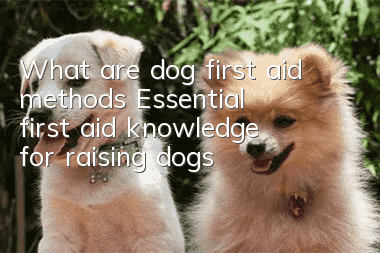What are dog first aid methods? Essential first aid knowledge for raising dogs

Emergency rescue
1. Regardless of whether the injured dog is conscious or not, as long as it is in danger, it must be removed. First check for obvious injuries, such as bleeding, dislocation, etc. Have someone stop approaching vehicles while you perform first aid for an injured dog.
2. If there is a second person to help, you can support the dog and lift it onto a blanket or coat. If you are alone, place a blanket next to the dog, firmly grasp the skin of the neck and buttocks, and pull the injured dog onto the blanket. Then lift the blanket and move the injured dog out of the injured area. Be careful not to touch the wound.
3. Dogs involved in traffic accidents may be injured and are in urgent need of veterinary diagnosis and treatment. Do not use excessive force when moving an injured dog. Use the blanket as a stretcher and carry him to the car to get him to the vet as soon as possible. Make sure that the neck is stretched to allow smooth breathing.
4. If the injured dog is in obvious pain, secure its muzzle with a temporary muzzle before moving it. Wrap a rope or scarf around your nose and tie knots under your chin and at the back of your neck.
5. Even if some dogs appear to be fine, their internal organs may be injured. After moving the injured dog to a safe place, give him a thorough examination. All dogs involved in traffic accidents should be examined by a veterinarian.
6. Gently touch the dog’s limbs to see if the bones are broken or misaligned. If you suspect a fracture, try not to move the injured leg. If the spine is injured, use a flat plate when lifting the injured dog.
7. If the injured dog is unconscious but breathing normally, you can press its gums with your fingers to see if the blood returns quickly when you release your hand. Rapid reflux may indicate massive bleeding. Apply firm pressure to the wound with an absorbent gauze pad or bandage to prevent external tearing and bleeding.
8. Some dogs are good at hiding their pain by being patient. Then, like extroverted dogs, they are at risk of contracting concussions, a complication after an accident. There are no obvious signs of internal bleeding and may not be noticed until the injured dog goes into shock. All injured dogs in traffic accidents should be sent to a veterinarian for examination and kept in the hospital for 24 hours for continued observation.
Judgement of Injury
1. Respiratory Check
Observe the dog’s chest movement to see if it is breathing. Normally, you breathe 20 to 30 times per minute. Respiratory rate often increases when you suffer an accidental injury. A short breath, followed by a sudden exhalation, indicates that the diaphragm has been damaged.
2. Light reflection
Shine a flashlight into the dog’s eyes and the pupils should contract. If the pupils are unresponsive, the heart may have stopped beating. If the pupils have become constricted, the dog may have suffered brain damage.
3. Foot reflex
Pinch the toes or the skin between the toes. If there is no response, it means that the injured dog is in a deep coma or the heart has stopped beating. If the injured dog is only slightly unconscious, it will retract its feet.
4. Identifying shock
Shock occurs when the body’s circulation stops. Shock can occur even hours after the accident. injured dogBecoming weak, short of breath, rapid pulse, and cold body.
5. Treatment of shock
If the shock is not due to heatstroke, you can wrap the injured dog in a blanket to keep warm. Don't wrap it too tightly and allow it to breathe easily. Also contact your veterinarian as soon as possible.
6. If the injury is severe and the victim has lost consciousness, stand the victim's neck upright, remove all residue from the mouth, and gently pull the tongue forward to avoid suffocation. This is particularly important for short-nosed dogs.
7. The injured dog may suddenly wake up. and became hysterical with pain and shock. Be careful not to injure it again by sitting up suddenly and violently. You should also take extra care yourself to avoid being bitten. If the injured dog is frightened, calm it down and keep it warm.
- What do dogs eat to protect their stomach? It is important to protect their stomach and treat gastrointestinal diseases in dogs.
- How to tell if your dog is fat? Is your dog overweight?
- Will your dog catch a cold if you blow the air conditioner? What should you do if your dog catches a cold if you blow the air conditioner?
- What should you pay attention to when your dog drinks water? Don’t be careless when it comes to your dog’s drinking water.
- The dog's mouth bites and shakes. Why does the dog's mouth occasionally shake and bite?
- How to cut a dog's hair? Do you know how to cut a dog's hair correctly?
- Can dogs eat raw eggs? Why can’t dogs eat egg whites?
- Common Dog Problems in Summer How to Deal with Different Dog Problems
- How to keep dogs away from skin diseases. If you do this, will you see if your dog will still be infected with skin diseases?
- What causes anorexia in dogs? Dogs will become anorexic due to lack of exercise. Hounds run at least 5KM every day.



